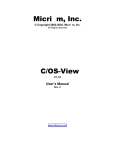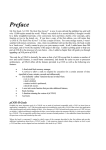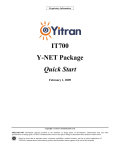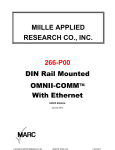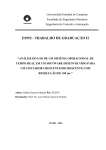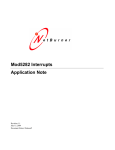Download A Portable Real-Time Kernel in C, 5/92
Transcript
<BACK
Embedded Systems Programming
BACK>
A Portable Real-Time Kernel in C
Just how much is a real-time multitasking kernel worth to you? If you're like many
developers, the benefits of using a commercial real-time operaing system or executive are
obvious. In exchange for a licensing fee, you get a debugged product with documentation
and technical support. Unfortunately, many developers find themselves in a SituatiOn
where they need a real-time operating system, but have virtually no budget for purchasing
one. What do you do in that situation? For many developers, the answer lies in creating
their own kernel.
Rolling your own executive or operating system can be appealing. Everyone likes to create
something new. But this approach isn't always practical and, in some cases, can be
downright dangerous. For example, it isn't often that you're given enough time to create
an operating system and complete your original project. On the few occasions when your
schedule is changed to reflect the extra work, the schedule may still be overly optimistic.
(It is a sad but well-established rule in our business that programmers will always
underestimate the time a project will take.) Worse, when you roll your own executive,
you're also volunteering for extra debugging and maintenance.
Despite the dangers I just mentioned, developers continue to take the plunge and develop
their own operating systems. I know this for a fact, because I've done it myself! The good
news is that you don't have to repeat the exercise. In this article, I'm going to explain the
design of uCOS, a portable, preemptive multitasking kernel for microcontrollers. I've
written this kernel almost entirely in C, and its performance is comparable to many
commercial kernels. Using my source code, you'll be able to avoid some of the costs of
creating your own kernel and spend more time on your application.
The creation and documentation for even a modest kernel can become an overwhelming
task. To keep things simple, this month, I'll be discussing the kernel internals and its
multitasking model at a relatively high level. Next month, I'll continue with a look at the
various kernel services.
THE NATURE OF THE PROJECT
UCOS stands for "microcontroller operating system." The initial goals for uCOS were to
create a small yet powerful kernel for Motorola's 68HC11 microcontroller. Specifically, I
wanted a ROMable real-time kernel with preemptive multitasking. As the design evolved,
however, I removed some of the target-specific limitations of uCOS to make it portable to
other microprocessors. Using this approach, I was able to develop and test uCOS on a PC
using Borland International's Turbo C + +. For this reason, the implementation of uCOS
shown in this article is for an Intel 80186/88 microprocessor (using the small memory
model).
The Intel 80186 was chosen as a target over the 8086 because the latter is a poor choice
for embedded control applications. An 8086/88 design would require additional support
circuitry. A minimal 80188 system can be built with four chips (80188, RAM, EPROM
and 8255 PPI).
UCOS FEATURES
Although it was developed on an IBM-PC compatible, uCOS is targeted for embedded
systems that use microcontrollers. The kernel is written almost entirely in C, with
microprocessor-specific code written in assembly language. A small amount of assembly
language was necessary but was kept to a minimum.
The uCOS source code is separated into five files. Three of these files contain targetspecific code. In our 80186 example, UCOS186.C contains the task-creation function,
UCOS 186.H is a header file, and UCOS186A.ASM contains the system-startup and
context-switching code. (The files mentioned here are in the UCOS.ZIP archive file on the
Embedded SystemsProgramming BBS at (415) 905-2389 or in library 12 of CLMFORUM
on CompuServe.) These files are where the target specifics are located.
The uCOS source code that is not target-specific is in the two remaining files, UCOS.H
and UCOS.C. The header file contains the system constants, data types, and function
prototypes, and UCOS.C file contains the system variables and functions.
Because of its organization, uCOS can be ported to just about any microprocessor. The
only requirements are that the microprocessor provides a stack pointer and the CPU
registers can be pushed onto and popped from the stack. Also, your C compiler must be
ANSI compatible and provide in-line assembly language or extensions that allow you to
enable and disable interrupts.
uCOS is priority driven and always runs the highest priority task that is ready to run.
uCOS is also fully preemptive, which means that interrupts can suspend the execution of a
task and, if a higher priority task is awakened as a result of the interrupt, it will run as
soon as the interrupt completes. uCOS also allows nested interrupts. Despite its flexibility,
I find uCOS comparable in performance to commercially available packages. For a
10MHz 80188 system, interrupt latency is less than 450 CPU bus cycles.
Another important characteristic of a real-time kernel is determinism. The execution time
of uCOS functions does not depend on the number of tasks in an application; the taskscheduling time is constant. uCOS supports systems with up to 63 user-definable tasks.
Since uCOS was originally targeted for an 8-bit microcontroller, only required kernel
services can be included in an application, which keeps the amount of EPROM and RAM
to a minimum. The stack size for each task can also be independently specified, which
further reduces the amount of RAM required.
uCOS provides a number of system services, including mailboxes, queues, semaphores,
and time-related functions. Most of these system services will be covered in next month's
article. The kernel is also very easy to set up, as will be demonstrated later.
I'll be the first to admit that uCOS has certain limitations. For example, tasks that execute
under the kernel must have a unique priority number. No two tasks can have the same
priority. Also, uCOS system calls cannot be made from nonmaskable interrupts because
the kernel needs to disable interrupts to execute critical sections of code. (By the way, this
limitation also exists in most commercially available kernels.) The execution time of the
function used to process a system tick depends on the number of tasks in an application.
CONVENTIONS
The following conventions are adopted in uCOS. All variables, functions, and macros in
uCOS start with 0S (for example, 0S-Start(), OSInit(), OS_STAT_RDY, and so on). This
way, uCOS functions can be easily identified in the user's application code.
Since the kernel is written in C, the size of certain data types are target-compiler specific.
To avoid confusion about the size of certain quantities, the following data types are
defined for the 80186/188 in UCOS186C.H:
* BYTE: signed 8-bit value
* UBYTE: unsigned 8-bit value
* WORD: signed 16-bit value
* UWORD: unsigned 16-bit value
* LONG: signed 32-bit value
* ULONG: unsigned 32-bit value
TASK CONTROL BLOCKS
Tasks under uCOS are characterized by the task control-block data structure OS_EB,
which is found in UCOS.H. An OS_TCB is used to hold the state of a task and other
system-related information.
OSTCBStkPtr contains a pointer to the current top of the stack for the task. uCOS allows
each task to have its own stack but, just as important, each stack can be of any size. Some
commercially available kernels assume that all stacks are the same size unless you write
complex hooks. This limitation becomes wasteful of RAM when all tasks have different
stack requirements because the largest anticipated stack size has to be allocated for all
tasks.
OSTCBStat contains the state of the task. When OSTCBStat is zero, the task is ready to
run. Each bit within OSTCBStat has a special meaning (see OS_STAT...).
OSTCBPrio contains the task priority. A high-priority task has a low priority number (the
lower the number, the higher the actual priority).
OSTCBDly is used when a task must be delayed for a certain number of system ticks or is
to wait for an event to occur with a timeout. In this case, this field contains the number of
system ticks that the task is allowed to wait for the event to occur. When this value is
zero, the task is not delayed.
OSTCBNext and OSTCBPrev are used to doubly link OSTCBs when tasks are created.
This chain of OSTCBs is used by OSTimeTick() (described later) to update the
OSTCBDly field for each task.
When uCOS is in the process of updating critical data structures, it must ensure that no
interruptions will occur. In this case, interrupts are disabled prior to executing this code
and reenabled when it is finished executing. The macros OS_ENTER_CRITICAL() and
OS_EXIT _CRITICAL() (in UCOS186C.H) are used to disable and enable interrupts,
respectively. These macros are included for portability.
TASK STATES
Figure 1 shows the state-transition diagram for tasks under uCOS. At any given time, a
task can be in any one of five states. The nOR-MINI state for a task corresponds to a task
that resides in EPROM but has not been made available to uCOS. A task is made available
to uCOS by calling OS-TaskCreate(), which can be found in UCOS 18 6C.C. When a task
is created, it is made ready to run. If the created task is the highest priority task that is
ready to run, it is immediately given the RUNNING state, and the task's code is executed
by the CPU. While the task is running, it may request from uCOS to wait for an event to
occur (PEND) or delay execution for a number of system ticks.
When a task requests such a service from uCOS, the next highest priority task is given
control of the CPU. When the event PENDed on occurs, the task is again made ready to
run and if it is the highest priority task, it is again given control of the CPU. Other services
are available to user tasks to notify other tasks that certain events have occured. A running
task may be interrupted, in which case the interrupt-service routine (ISR) takes control of
the CPU. The ISR may make one or more tasks ready to run by signaling that one or more
events occurred. In this case, before returning from the ISR, uCOS determines if the
interrupted task is still the highest priority task that is ready to run. If a higher priority task
is made ready to run by the ISR, the previous task is preempted and the new highest
priority task is resumed. Otherwise, the interrupted task is resumed.
When all tasks are either waiting for events or delayed for a number of system ticks, uCOS
executes an idle task, OSTaskIdle().
TASK CREATION
As previously mentioned, tasks are created by calling OSTask-Create(). Tasks can be
created prior to the start of multitasking or by a running task. A task cannot be created by
an ISR. OSTaskCreate() is passed four arguments, task is a pointer to the task's code. data
is a pointer to a user-definable data area, which is used to pass arguments to the task. pstk
is a pointer to the task's stack area, which is used to store local variables and CPU
registers during an interrupt. The size of this stack is defined by the task requirements and
the anticipated interrupt nesting. Determining the size of the stack involves knowing how
many bytes are required to store the local variables for the task, all nested functions, and
the requirements for interrupts (accounting for nesting). p is the task priority. A unique
priority number must be assigned to each task--the lower the number, the higher the
priority.
When a task is created, it is assigned an OS_TCB, which is then initialized. The task stack
is initialized to make it look as if an interrupt occurred and the CPU registers were saved
onto it. The stack frame of a created task is shown in Figure 2. A pointer to the task's
OS_TCB is placed in OSTCBPrioTbl[] (UCOS.C) using the task priority as the index.
The task's OS_TCB is then inserted in a doubly linked list with OSTCBList (UCOS.C)
pointing to the most recently created task. The task is then inserted in a ready list and the
scheduler is called to determine if the created task is now the highest priority task that is
ready to run.
TASK SCHEDULING
Task scheduling is performed by OSSched() (UCOS.C). uCOS's task-scheduling time is
constant regardless of the number of tasks created in an application (up to 63 user tasks).
Each task is assigned a unique priority level between zero and 63. Task-priority 63 is
always assigned to uCOS's idle task when the kernel is initialized.
Task priorities are grouped (eight tasks per group) in OSRdyGrp (UCOS.C). Each bit in
OSBdyGrp is used to indicate that a task in a group is ready to run. When a task is ready
to run, it also sets its corresponding bit in the ready list table, OSRdyTbl[]. To determine
which priority (and thus which task) will run next, the scheduler determines the lowest
priority number that has its bit set in OSRdyTbl[ ]. Tasks are made ready to run by
executing the following section of code:
OSRdyGrp |=OSMapTbl[p >> 3];
OSRdyTbl[p >> 3] |=OSMapTbl[p & 0x07];
This code sets the ready bit of the task in OSRdyTbl[8] based on its priority number, p.
Similarly, a task is removed from the ready list by executing the following section of code:
if ((OSRdyTbl [p >> 3] &=
~OSMapTbl[p & 0x07] == 0)
OSRdyGrp &= ~OSMapTbl[p >> 3];
and clears the bit in OSRdyGrp if all tasks in a group are not ready to run. Instead of
scanning through the table starting with OSRdyTbl[O] to find the highest priority task that
is ready to run, a table-lookup method is used. OSUnMapTbl[256] is a priority resolution
table. Eight bitsare used to represent tasks that are ready. The least significant bit has the
highest priority. Using this byte to index the table returns the bit position of the highest
priority bit set, a number between zero and seven. To avoid a context switch, OSSched()
verities that the highest priority task is not the current task.
All of the code in OSSched() is considered a critical section. Interrupts are disabled to
prevent ISRs from setting the ready bit of one or more tasks while the highest priority task
that is ready to run is being determined. OSSched() could have been written in assembly
language, since task-scheduling time and interrupt latency are directly proportional to the
execution time of this function. This code was kept in C to make it more readable for the
purpose of this article.
CONTEXT SWITCHING
When a context switch from OSSched() is required, OS_TASK_SW() is executed.
OS_TASK_SW(), which is actually a macro defining an INT instruction, vectors to the
assembly language ISR OSCtxSw (UCOS186A.ASM), which performs the context
switch. Remember that a task stack is initially set up to look as if an interrupt occurred
(see Figure 2). OsCtxSw expects the current task's stacks and the new highest priority
task that is ready to run to look pretty much the same. The INT instruction pushed the
processor's PSW and the current task's code segment and offset onto the stack. OSCtxSw
starts by saving the rest of the current task's context onto the stack. The processor's stack
pointer for the current task is finally saved in the current task's TCB. The stack pointer of
the next task to run is restored from its TCB (the new task's context is restored). At this
point, the lower priority task's information is stored on the stack. OSCtxSw finally
executes a return from interrupt to resume execution of the highest priority task.
INTERRUPT PROCESSING
When an interrupt occurs, the processor will automatically save the current PSW, CS, and
IP onto the current task's stack, then fetch the interrupt vector from the interrupt-vector
table. If an ISR needs to use the kernel's services, it should immediately enable interrupts
to allow interrupt nesting (and reduce interrupt latency) and call OSIntEnter() (UCOS.C)
to notify uCOS that it has started servicing an interrupt. The user's ISR code should
follow, followed by a call to OSIntExit() (UCOS.C). The ISR code must be written in
assembly language under uCOS as follows:
ISRx PROC FAR
STI
; Enable interrupts
PUSHA
; Save CPU's context
PUSH ES
CALL _OSIntEnter
; Notify uCOS of ISR
CALL _User ISRCode
; Execute user code
CALL _OSIntExit
; Notify uCOS of
;end of ISR
POP ES
; Restore CPU's
; context
POPA
IRET
; Return from
; interrupt
OSIntEnter() is used to notify uCOS that an ISR has started, allowing uCOS to keep track
of the interrupt-nesting level. uCOS allows nesting of up to 255 interrupts. When the ISR
completes, it calls OSIntExit(), which decrements the nesting level. When all interrupts
have completed, uCOS finds the highest priority task that is ready to run and switches to
that task. Notice that OSIntExit() calls OSIntCtxSw() instead of OSCtxSw. This call is
made because uCOS allocates local storage for variables on the stack that are used by
OSinExit(). These variables must be deallocated prior to returning to the interrupted task
or the highest priority task.
SYSTEM TICK
UCOS allows tasks to suspend execution for a number of system ticks or wait until events
occur with a timeout. A system tick is typically provided by a periodic interrupt. The time
between interrupts is application specific and is typically between 10 milliseconds and 100
milliseconds--the faster the tick rate, the higher the overhead imposed on the system.
Overhead imposed by uCOS is about 3% (worst case) when the tick rate is 20Hz (50
milliseconds). The ISR OSTickISR (UCOS186A.ASM) shows how to implement a
system-tick interrupt under uCOS. Notice that OSTime-Tick() is called. This function is
used to decrement the OSTCBDly field for each OS_TCB if it is nonzero. When
OSTBDly is decremented to zero, the task is made ready to run. The execution time of
OSTimeTick() is directly proportional to the number of tasks created in an application
(approximately 15,000 bus cycles worst-case with 63 tasks). Before returning to the
interrupted task (or the highest priority task that is ready to run) an INT OF2H is
performed to chain into the IBM-PC's BIOS-tick ISR (used only for the example). When
the BIOS returns from this interrupt, OSTickISR properly terminates the ISR as required
by uCOS.
SYSTEM SERVICES
The uCOS kernel offers a number of services to the programmer. In next month's
continuation, we'll look at most of the uCOS services. It should be mentioned for the
impatient, however, that one of the most basic kernel services is to allow a task to delay
execution for a number of system ticks. The function that performs this operation is called
OSTimeDly(), which is found in UCOS.C.
The kernel is initialized by calling OsInit(), also in UCOS.C, which is also where the idle
task is created. You must specify a pointer to the idle stack and the maximum number of
tasks in your application. After calling OSInit(), you may create your application tasks.
Multitasking starts when you call OSStart(). OsInit() must be called before OSStart() and
you must create at least one of your tasks prior to calling OSStart(). OSStart() will
execute the highest priority task that you created.
PERFORMANCE ISSUES
A number of criteria can alter the performance of a real-time kernel. Context-switch time,
interrupt latency, system-services execution time, and task-scheduling time all have some
effect.
The context-switch time is really determined by the microprocessor and typically doesn't
change from one kernel to another. Saving and restoring a processor's context depends on
how many registers it has. In my experience, it's not very meaningful when a kernel vendor
quotes performance based on the context-switch time.
An important criterion for a multi-tasking kernel is how long it takes to respond to an
interrupt and start executing user code for the ISR. This procedure is known as interrupt
latency. A real-time kernel always disables interrupts when manipulating critical sections
of code. For uCOS, interrupts are disabled for a maximum of 450 CPU bus cycles. In
addition to the period when interrupts are disabled, if uCOS services are required, you
must also include the overhead for an ISR preamble. uCOS requires an additional 200
cycles before it starts executing user code. Interrupt latency for uCOS is thus about 650
bus cycles, or 65 microseconds for a 10MHz 80188 system.
Another important performance issue in a real-time kernel is determinism. Kernel services
should be deterministic by specifying how long each service call will take to execute. The
execution time of uCOS's kernel services does not depend on the number of tasks in an
application. This characteristic is desirable, since you don't want the kernel's performance
to degrade as the number of tasks in an application increases. Table 1 lists the execution
time of the services described in this article. It was obtained by inspecting the code
generated by the compiler and adding up the number of cycles for each instruction. An
Intel 80188 processor with zero wait states is assumed. To find the execution time of each
kernel service, simply divide the number of cycles given by the processor bus frequency.
The time required by uCOS to find the highest priority task that is ready to run is constant.
If the current task has the highest priority and is ready to run (for example, no context
switch is required) then OSSched() executes in about 250 bus cycles. If a context switch is
required, execution time is about 500 bus cycles.
MEMORY REQUIREMENTS
Given the limited amount of memory typically found in embedded systems (especially with
8-bit microprocessors) the amount Of program and data memory a kernel requires must be
kept to a minimum. The RAM requirements for a small model 80188 implementation of
uCOS is fairly simple to calculate:
RAM = uCOS requirements +
Task stacks +
Storage of OS_TCBs for all tasks
= 150 + SUM(Task Stacks) +
(OS_TCB size) * (N + 1)
where N is the number of tasks created for the application. uCOS requires 150 bytes for
its internal data structures and variables. The size of an OS_TCB is 10 bytes and one extra
OS_TCB is required to hold the idle task. The total stack requirement is the sum of the
stack requirement for each task. For example, a 20-task application using 256 bytes for
each stack would require:
RAM = 150 + 10*(20 + 1) + 21 *256;
= 5,736 bytes.
uCOS requires less than 1,000 bytes of EPROM, excluding the kernel services that I'll
describe next month. Our example application requires an additional 300 bytes (excluding
the library functions).
StiLL TO COME
Next month, we'll conclude our look at uCOS with a tour of the system services. If you're
planning to use the kernel in a project, you might want to hold off on your customization
efforts until you examine those services. If you're in a hurry, the code presented this month
allows you to run the example shown in Listing 1, TEST1.C. This code creates five tasks.
Each task delays for one BIOS tick (approximately 55 milliseconds) and displays its
priority number at random positions on the screen. The same code is used for each task
and the displayed task priority is passed to the task when it is created through the data
argument. This type of code can be used for multiple instances of a task as long as the task
is reentrant. The code in the example works--even though the functions used are not
reentrant (trust me on this). Be careful when using floating-point math in your application-Turbo C + +'s math library is nonreentrant.
The selection of services and other system parameters are based on my experience and
seemed a good fit for embedded microcontroller applications. Your experience may be
different. I've provided the source code so you can make your own modifications. For
example, all of the projects that I've worked on have had less than 35 tasks. Hence, the
kernel limit of 63 tasks seemed quite adequate. If needed, however, uCOS can easily be
upgraded to handle up to 127 user tasks. To make such changes easier, I've stressed
readability over "optimization." I hope you find the results useful.
BY JEAN J. LABROSSE
Jean J. Labrosse has a Master's degree in Electrical Engineering from the University of
Sherbrooke in Quebec, Canada, and has been developing real-time software for over 10
years. He is intimately familiar with the Z-80, 680x, 80x86, 680x0, 6805 and 68HC11
microprocessors. Labrosse is employed by Dynalco Controls in Fort Lauderdale, Fla.,
where he designs control software for large industrial reciprocating engines.
BIBLIOGRAPHY
Bal Sathe, Dhananjay. "Fast Algorithm Determines Priority," India EDN, Sept. 1988,
p.237.
iAPX 186/188 User's Manual and Programmer's Reference. Santa Clara, Calif.: Intel
Corp., 1983.
@@Listing 1
A multitasking test program.
#include "INCLUDES.H"
#define
OS_MAX_TASKS
#define
STK_SIZE
OS_TCB
10
500
OSTCBTbl[OS_MAX_TASKS];
UWORD
OSIdleTaskStk[STK_SIZE];
UWORD
Stk1[STK_SIZE];
UWORD
Stk2[STK_SIZE];
UWORD
Stk3[STK_SIZE];
UWORD
Stk4[STK_SIZE];
UWORD
Stk5[STK_SIZE];
char
Data1 = '1';
char
Data2 = '2';
char
Data3 = '3';
char
Data4 = '4';
char
Data5 = '5';
void far
Task(void *data);
void interrupt (*OldTickISR)(void);
void main(void)
{
UBYTE err;
clrscr();
OldTickISR = getvect(0x08);
setvect(UCOS, (void interrupt
(*)(void))OSCtxSw);
setvect(OxF2, OldTickISR);
OSInit(&OSIdleTaskStk[STK_SIZE],
OS_MAX_TASKS);
OSTaskCreate(Task, (void *)&Data1,
(void *)&Stk1[STK_SIZE], 1);
OSTaskCreate(Task, (void *)&Data2,
(void *)&Stk2[STK_SIZE], 2);
OSTaskCreate(Task, (void *)&Data3,
(void *)&Stk3[STK_SIZE], 3);
OSTaskCreate(Task, (void *)&Data4,
(void *)&Stk4[STK_SIZE], 4);
OSTaskCreate(Task, (void *)&Data5,
(void *)&Stk5[STK_SIZE], 5);
OSStart();
}
void far Task(void *data)
{
setvect(0x08, (void interrupt
(*)(void))OSTickISR);
while (1) {
OSTimeDly(1);
gotoxy(rand() % 79 + 1, rand() % 25 + 1);
putch(*(char *)data);
if (kbhit()) {
setvect(0x08, OldTickISR);
exit(0);
}
}
}












